BOICNMT220 Change Management: Factors in Choosing Change Agents
VerifiedAdded on 2023/06/11
|10
|2336
|365
Essay
AI Summary
This essay explores the critical factors organizations must consider when choosing between internal and external change agents to lead organizational change. It defines organizational change as a process that can involve various areas, such as operational methods, technologies, structure, or culture, and highlights that such changes can be planned or unplanned, driven by internal or external pressures. The essay details the benefits of organizational change, including improved performance, employee growth, and company relevance. It then discusses the roles, advantages, and disadvantages of both internal and external change agents, emphasizing that internal agents possess intimate knowledge of the organization, while external agents bring specialized expertise and objectivity. Key factors determining the choice of change agent include financial constraints, employee resistance to change, the complexity of the proposed change, and the sensitivity of the change. The essay concludes that change is inevitable and beneficial if managed effectively, underscoring the importance of selecting the right change agent to ensure successful implementation.
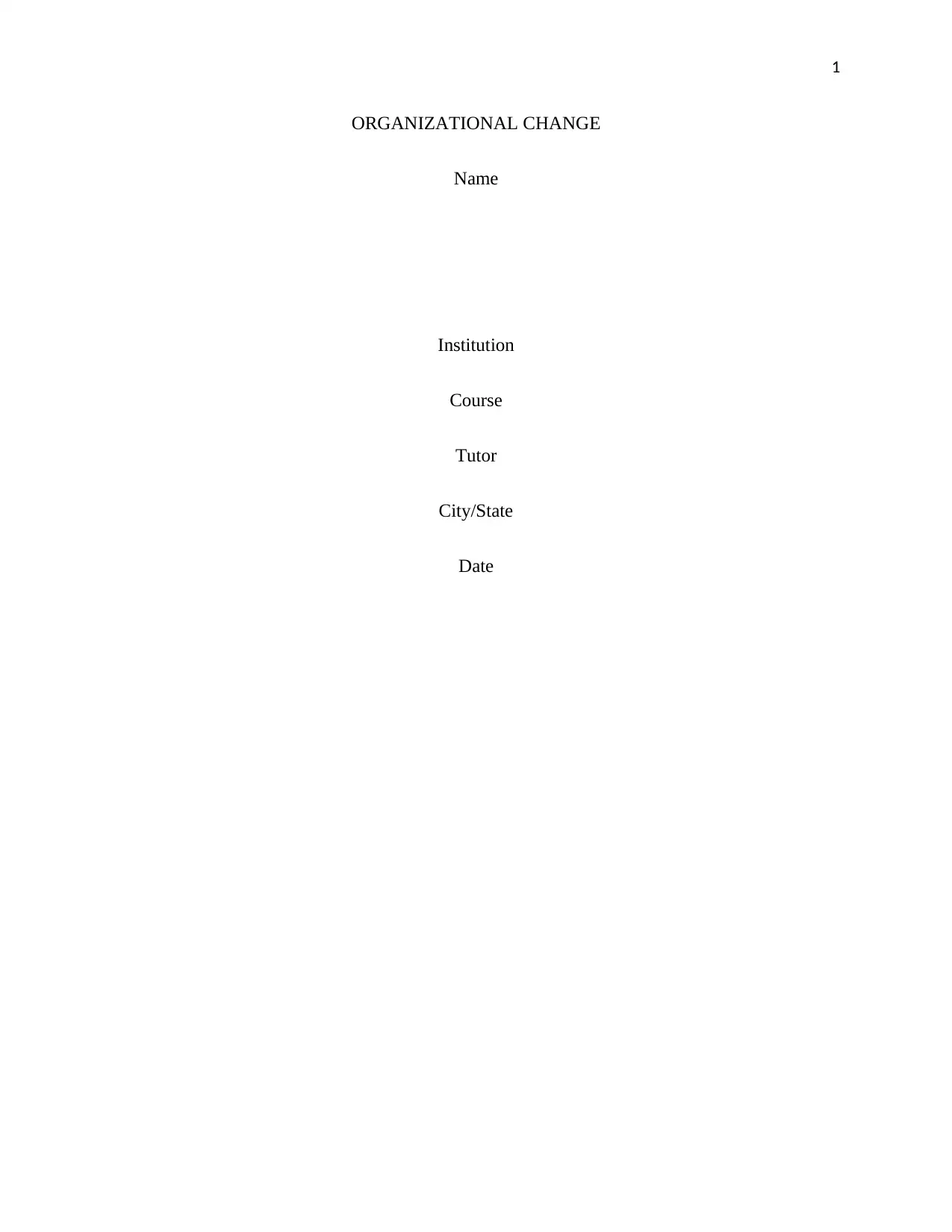
1
ORGANIZATIONAL CHANGE
Name
Institution
Course
Tutor
City/State
Date
ORGANIZATIONAL CHANGE
Name
Institution
Course
Tutor
City/State
Date
Paraphrase This Document
Need a fresh take? Get an instant paraphrase of this document with our AI Paraphraser
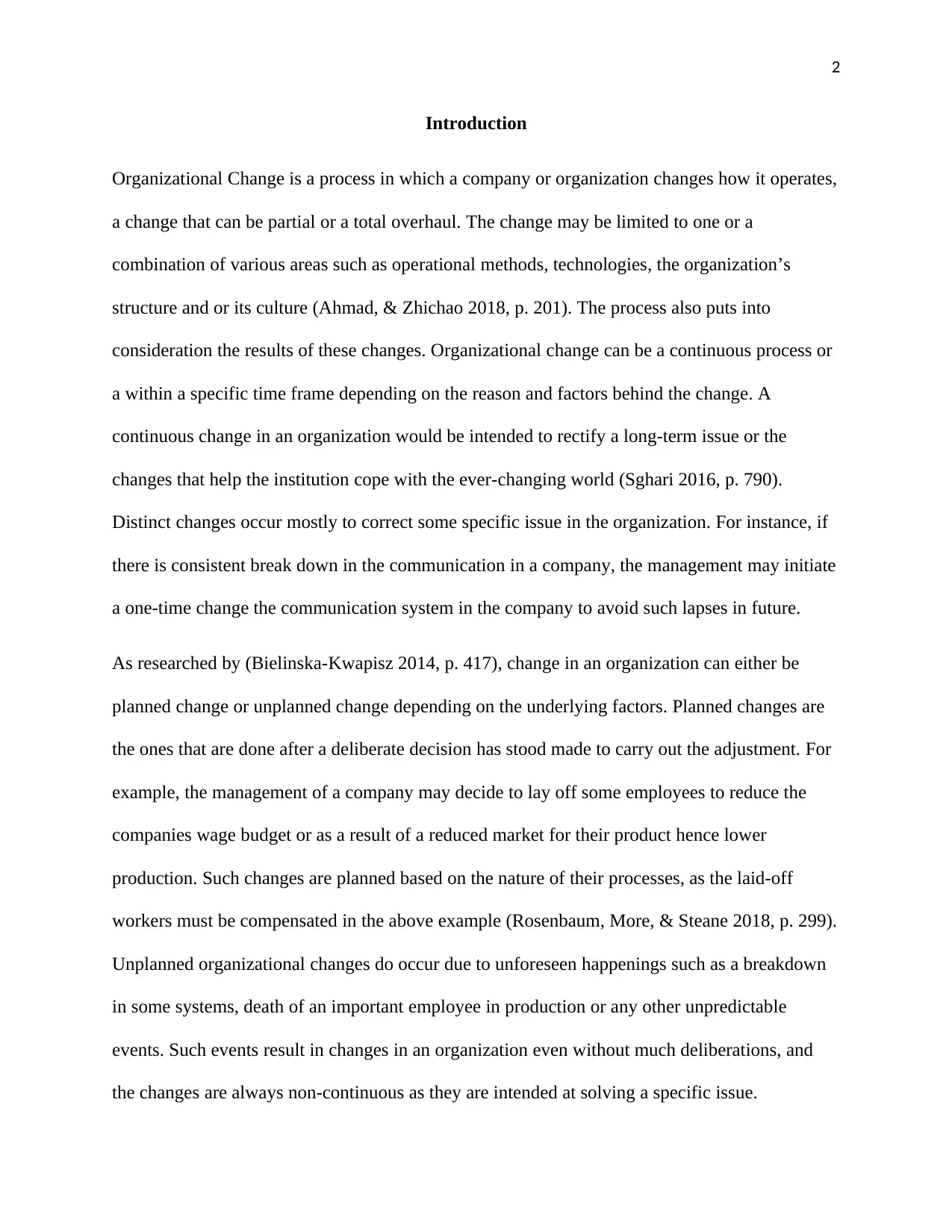
2
Introduction
Organizational Change is a process in which a company or organization changes how it operates,
a change that can be partial or a total overhaul. The change may be limited to one or a
combination of various areas such as operational methods, technologies, the organization’s
structure and or its culture (Ahmad, & Zhichao 2018, p. 201). The process also puts into
consideration the results of these changes. Organizational change can be a continuous process or
a within a specific time frame depending on the reason and factors behind the change. A
continuous change in an organization would be intended to rectify a long-term issue or the
changes that help the institution cope with the ever-changing world (Sghari 2016, p. 790).
Distinct changes occur mostly to correct some specific issue in the organization. For instance, if
there is consistent break down in the communication in a company, the management may initiate
a one-time change the communication system in the company to avoid such lapses in future.
As researched by (Bielinska-Kwapisz 2014, p. 417), change in an organization can either be
planned change or unplanned change depending on the underlying factors. Planned changes are
the ones that are done after a deliberate decision has stood made to carry out the adjustment. For
example, the management of a company may decide to lay off some employees to reduce the
companies wage budget or as a result of a reduced market for their product hence lower
production. Such changes are planned based on the nature of their processes, as the laid-off
workers must be compensated in the above example (Rosenbaum, More, & Steane 2018, p. 299).
Unplanned organizational changes do occur due to unforeseen happenings such as a breakdown
in some systems, death of an important employee in production or any other unpredictable
events. Such events result in changes in an organization even without much deliberations, and
the changes are always non-continuous as they are intended at solving a specific issue.
Introduction
Organizational Change is a process in which a company or organization changes how it operates,
a change that can be partial or a total overhaul. The change may be limited to one or a
combination of various areas such as operational methods, technologies, the organization’s
structure and or its culture (Ahmad, & Zhichao 2018, p. 201). The process also puts into
consideration the results of these changes. Organizational change can be a continuous process or
a within a specific time frame depending on the reason and factors behind the change. A
continuous change in an organization would be intended to rectify a long-term issue or the
changes that help the institution cope with the ever-changing world (Sghari 2016, p. 790).
Distinct changes occur mostly to correct some specific issue in the organization. For instance, if
there is consistent break down in the communication in a company, the management may initiate
a one-time change the communication system in the company to avoid such lapses in future.
As researched by (Bielinska-Kwapisz 2014, p. 417), change in an organization can either be
planned change or unplanned change depending on the underlying factors. Planned changes are
the ones that are done after a deliberate decision has stood made to carry out the adjustment. For
example, the management of a company may decide to lay off some employees to reduce the
companies wage budget or as a result of a reduced market for their product hence lower
production. Such changes are planned based on the nature of their processes, as the laid-off
workers must be compensated in the above example (Rosenbaum, More, & Steane 2018, p. 299).
Unplanned organizational changes do occur due to unforeseen happenings such as a breakdown
in some systems, death of an important employee in production or any other unpredictable
events. Such events result in changes in an organization even without much deliberations, and
the changes are always non-continuous as they are intended at solving a specific issue.
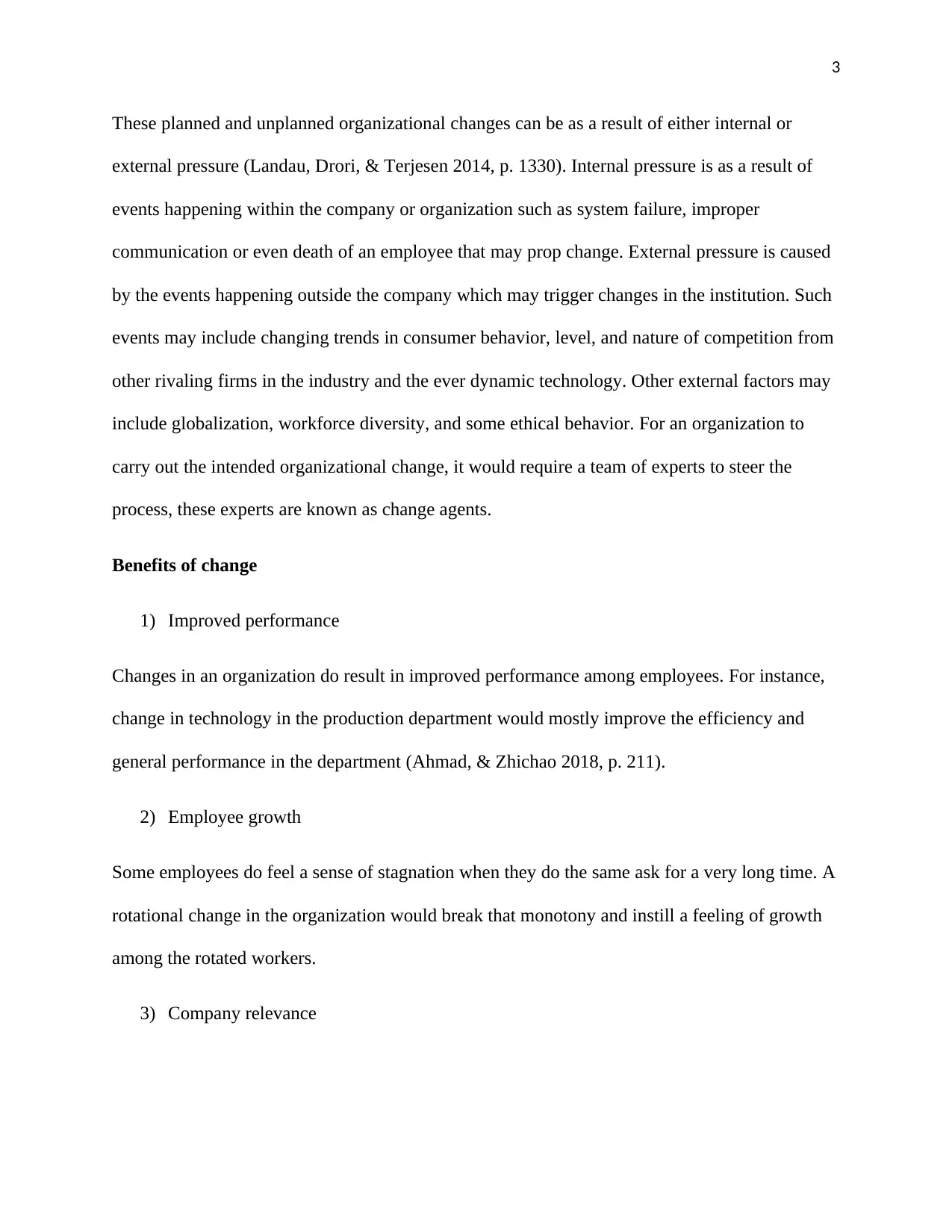
3
These planned and unplanned organizational changes can be as a result of either internal or
external pressure (Landau, Drori, & Terjesen 2014, p. 1330). Internal pressure is as a result of
events happening within the company or organization such as system failure, improper
communication or even death of an employee that may prop change. External pressure is caused
by the events happening outside the company which may trigger changes in the institution. Such
events may include changing trends in consumer behavior, level, and nature of competition from
other rivaling firms in the industry and the ever dynamic technology. Other external factors may
include globalization, workforce diversity, and some ethical behavior. For an organization to
carry out the intended organizational change, it would require a team of experts to steer the
process, these experts are known as change agents.
Benefits of change
1) Improved performance
Changes in an organization do result in improved performance among employees. For instance,
change in technology in the production department would mostly improve the efficiency and
general performance in the department (Ahmad, & Zhichao 2018, p. 211).
2) Employee growth
Some employees do feel a sense of stagnation when they do the same ask for a very long time. A
rotational change in the organization would break that monotony and instill a feeling of growth
among the rotated workers.
3) Company relevance
These planned and unplanned organizational changes can be as a result of either internal or
external pressure (Landau, Drori, & Terjesen 2014, p. 1330). Internal pressure is as a result of
events happening within the company or organization such as system failure, improper
communication or even death of an employee that may prop change. External pressure is caused
by the events happening outside the company which may trigger changes in the institution. Such
events may include changing trends in consumer behavior, level, and nature of competition from
other rivaling firms in the industry and the ever dynamic technology. Other external factors may
include globalization, workforce diversity, and some ethical behavior. For an organization to
carry out the intended organizational change, it would require a team of experts to steer the
process, these experts are known as change agents.
Benefits of change
1) Improved performance
Changes in an organization do result in improved performance among employees. For instance,
change in technology in the production department would mostly improve the efficiency and
general performance in the department (Ahmad, & Zhichao 2018, p. 211).
2) Employee growth
Some employees do feel a sense of stagnation when they do the same ask for a very long time. A
rotational change in the organization would break that monotony and instill a feeling of growth
among the rotated workers.
3) Company relevance
⊘ This is a preview!⊘
Do you want full access?
Subscribe today to unlock all pages.

Trusted by 1+ million students worldwide
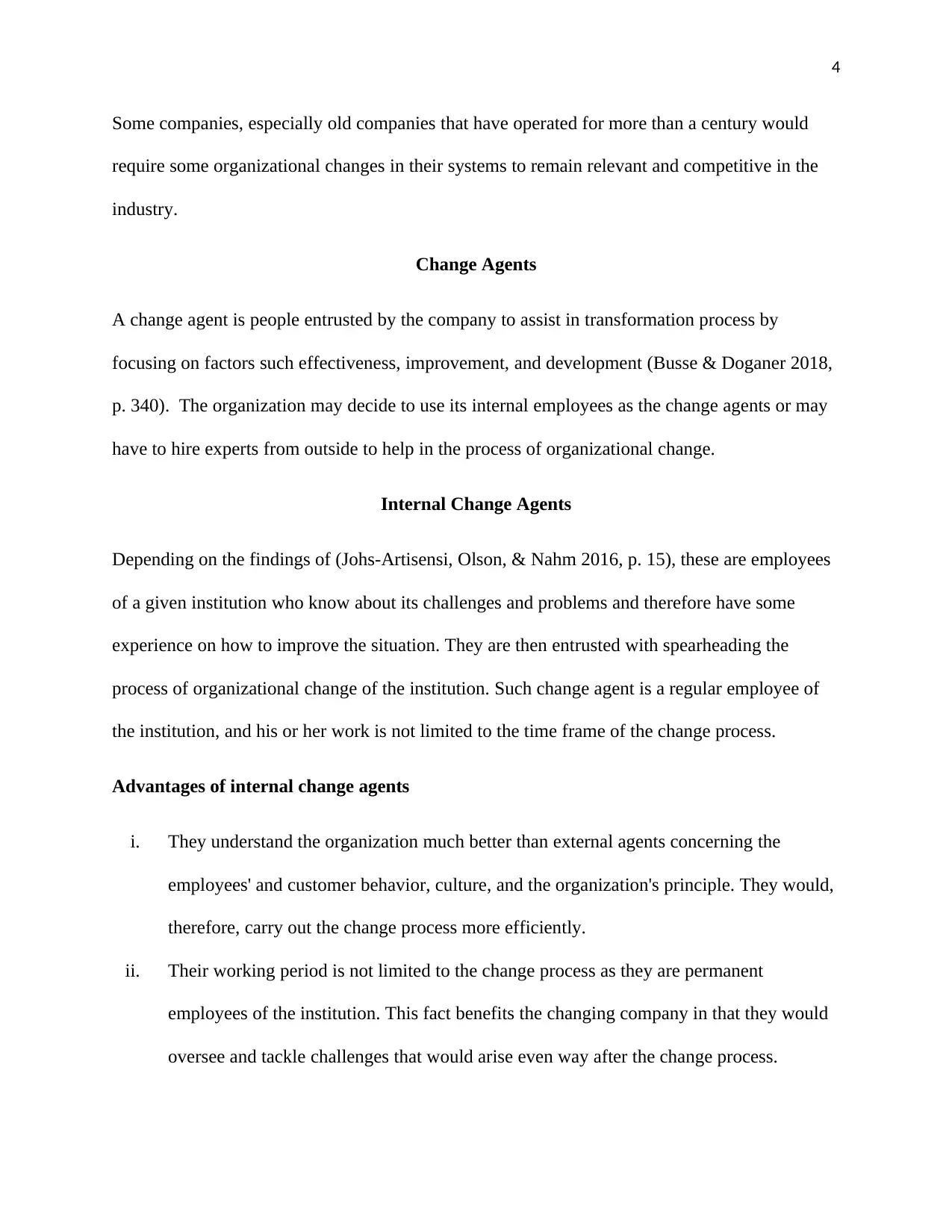
4
Some companies, especially old companies that have operated for more than a century would
require some organizational changes in their systems to remain relevant and competitive in the
industry.
Change Agents
A change agent is people entrusted by the company to assist in transformation process by
focusing on factors such effectiveness, improvement, and development (Busse & Doganer 2018,
p. 340). The organization may decide to use its internal employees as the change agents or may
have to hire experts from outside to help in the process of organizational change.
Internal Change Agents
Depending on the findings of (Johs-Artisensi, Olson, & Nahm 2016, p. 15), these are employees
of a given institution who know about its challenges and problems and therefore have some
experience on how to improve the situation. They are then entrusted with spearheading the
process of organizational change of the institution. Such change agent is a regular employee of
the institution, and his or her work is not limited to the time frame of the change process.
Advantages of internal change agents
i. They understand the organization much better than external agents concerning the
employees' and customer behavior, culture, and the organization's principle. They would,
therefore, carry out the change process more efficiently.
ii. Their working period is not limited to the change process as they are permanent
employees of the institution. This fact benefits the changing company in that they would
oversee and tackle challenges that would arise even way after the change process.
Some companies, especially old companies that have operated for more than a century would
require some organizational changes in their systems to remain relevant and competitive in the
industry.
Change Agents
A change agent is people entrusted by the company to assist in transformation process by
focusing on factors such effectiveness, improvement, and development (Busse & Doganer 2018,
p. 340). The organization may decide to use its internal employees as the change agents or may
have to hire experts from outside to help in the process of organizational change.
Internal Change Agents
Depending on the findings of (Johs-Artisensi, Olson, & Nahm 2016, p. 15), these are employees
of a given institution who know about its challenges and problems and therefore have some
experience on how to improve the situation. They are then entrusted with spearheading the
process of organizational change of the institution. Such change agent is a regular employee of
the institution, and his or her work is not limited to the time frame of the change process.
Advantages of internal change agents
i. They understand the organization much better than external agents concerning the
employees' and customer behavior, culture, and the organization's principle. They would,
therefore, carry out the change process more efficiently.
ii. Their working period is not limited to the change process as they are permanent
employees of the institution. This fact benefits the changing company in that they would
oversee and tackle challenges that would arise even way after the change process.
Paraphrase This Document
Need a fresh take? Get an instant paraphrase of this document with our AI Paraphraser
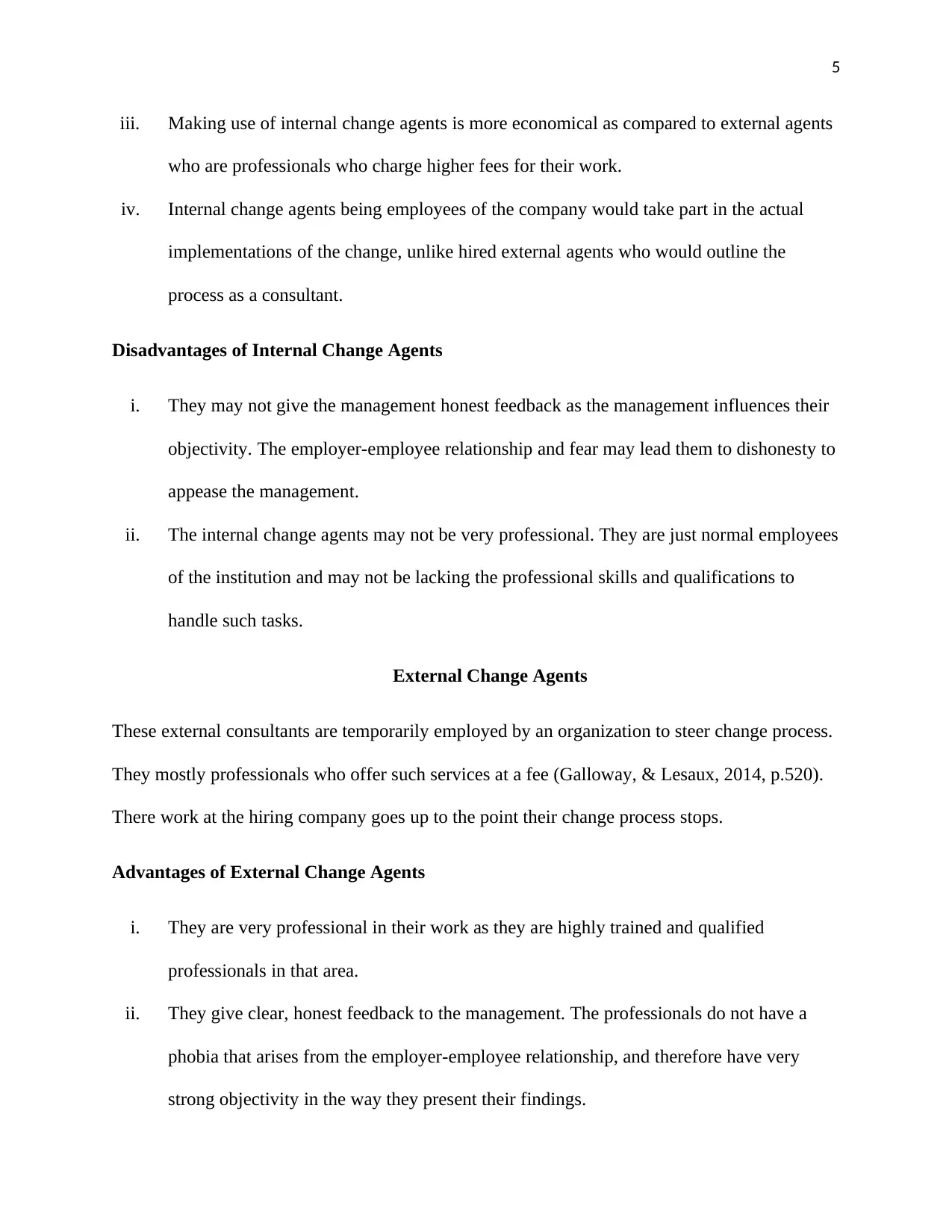
5
iii. Making use of internal change agents is more economical as compared to external agents
who are professionals who charge higher fees for their work.
iv. Internal change agents being employees of the company would take part in the actual
implementations of the change, unlike hired external agents who would outline the
process as a consultant.
Disadvantages of Internal Change Agents
i. They may not give the management honest feedback as the management influences their
objectivity. The employer-employee relationship and fear may lead them to dishonesty to
appease the management.
ii. The internal change agents may not be very professional. They are just normal employees
of the institution and may not be lacking the professional skills and qualifications to
handle such tasks.
External Change Agents
These external consultants are temporarily employed by an organization to steer change process.
They mostly professionals who offer such services at a fee (Galloway, & Lesaux, 2014, p.520).
There work at the hiring company goes up to the point their change process stops.
Advantages of External Change Agents
i. They are very professional in their work as they are highly trained and qualified
professionals in that area.
ii. They give clear, honest feedback to the management. The professionals do not have a
phobia that arises from the employer-employee relationship, and therefore have very
strong objectivity in the way they present their findings.
iii. Making use of internal change agents is more economical as compared to external agents
who are professionals who charge higher fees for their work.
iv. Internal change agents being employees of the company would take part in the actual
implementations of the change, unlike hired external agents who would outline the
process as a consultant.
Disadvantages of Internal Change Agents
i. They may not give the management honest feedback as the management influences their
objectivity. The employer-employee relationship and fear may lead them to dishonesty to
appease the management.
ii. The internal change agents may not be very professional. They are just normal employees
of the institution and may not be lacking the professional skills and qualifications to
handle such tasks.
External Change Agents
These external consultants are temporarily employed by an organization to steer change process.
They mostly professionals who offer such services at a fee (Galloway, & Lesaux, 2014, p.520).
There work at the hiring company goes up to the point their change process stops.
Advantages of External Change Agents
i. They are very professional in their work as they are highly trained and qualified
professionals in that area.
ii. They give clear, honest feedback to the management. The professionals do not have a
phobia that arises from the employer-employee relationship, and therefore have very
strong objectivity in the way they present their findings.
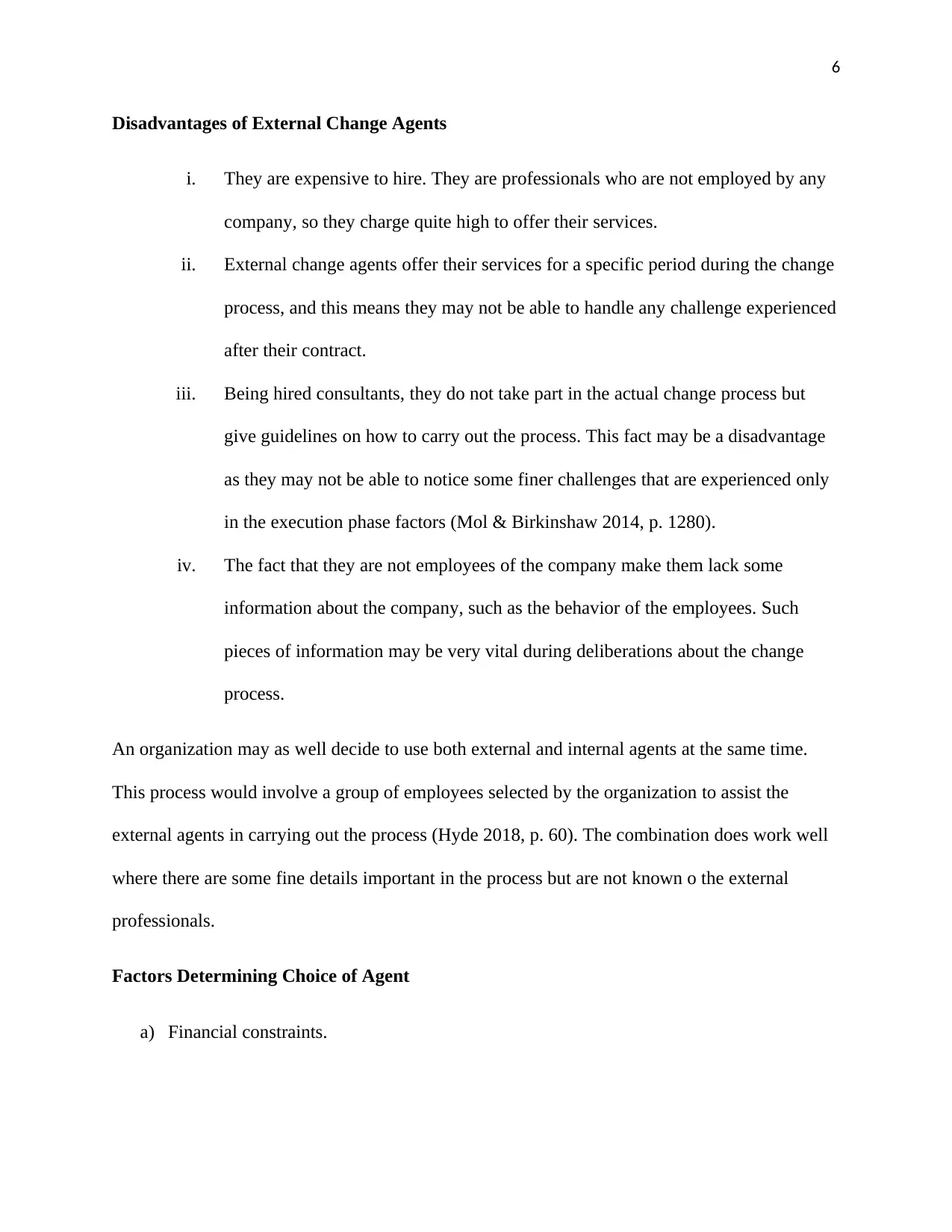
6
Disadvantages of External Change Agents
i. They are expensive to hire. They are professionals who are not employed by any
company, so they charge quite high to offer their services.
ii. External change agents offer their services for a specific period during the change
process, and this means they may not be able to handle any challenge experienced
after their contract.
iii. Being hired consultants, they do not take part in the actual change process but
give guidelines on how to carry out the process. This fact may be a disadvantage
as they may not be able to notice some finer challenges that are experienced only
in the execution phase factors (Mol & Birkinshaw 2014, p. 1280).
iv. The fact that they are not employees of the company make them lack some
information about the company, such as the behavior of the employees. Such
pieces of information may be very vital during deliberations about the change
process.
An organization may as well decide to use both external and internal agents at the same time.
This process would involve a group of employees selected by the organization to assist the
external agents in carrying out the process (Hyde 2018, p. 60). The combination does work well
where there are some fine details important in the process but are not known o the external
professionals.
Factors Determining Choice of Agent
a) Financial constraints.
Disadvantages of External Change Agents
i. They are expensive to hire. They are professionals who are not employed by any
company, so they charge quite high to offer their services.
ii. External change agents offer their services for a specific period during the change
process, and this means they may not be able to handle any challenge experienced
after their contract.
iii. Being hired consultants, they do not take part in the actual change process but
give guidelines on how to carry out the process. This fact may be a disadvantage
as they may not be able to notice some finer challenges that are experienced only
in the execution phase factors (Mol & Birkinshaw 2014, p. 1280).
iv. The fact that they are not employees of the company make them lack some
information about the company, such as the behavior of the employees. Such
pieces of information may be very vital during deliberations about the change
process.
An organization may as well decide to use both external and internal agents at the same time.
This process would involve a group of employees selected by the organization to assist the
external agents in carrying out the process (Hyde 2018, p. 60). The combination does work well
where there are some fine details important in the process but are not known o the external
professionals.
Factors Determining Choice of Agent
a) Financial constraints.
⊘ This is a preview!⊘
Do you want full access?
Subscribe today to unlock all pages.

Trusted by 1+ million students worldwide
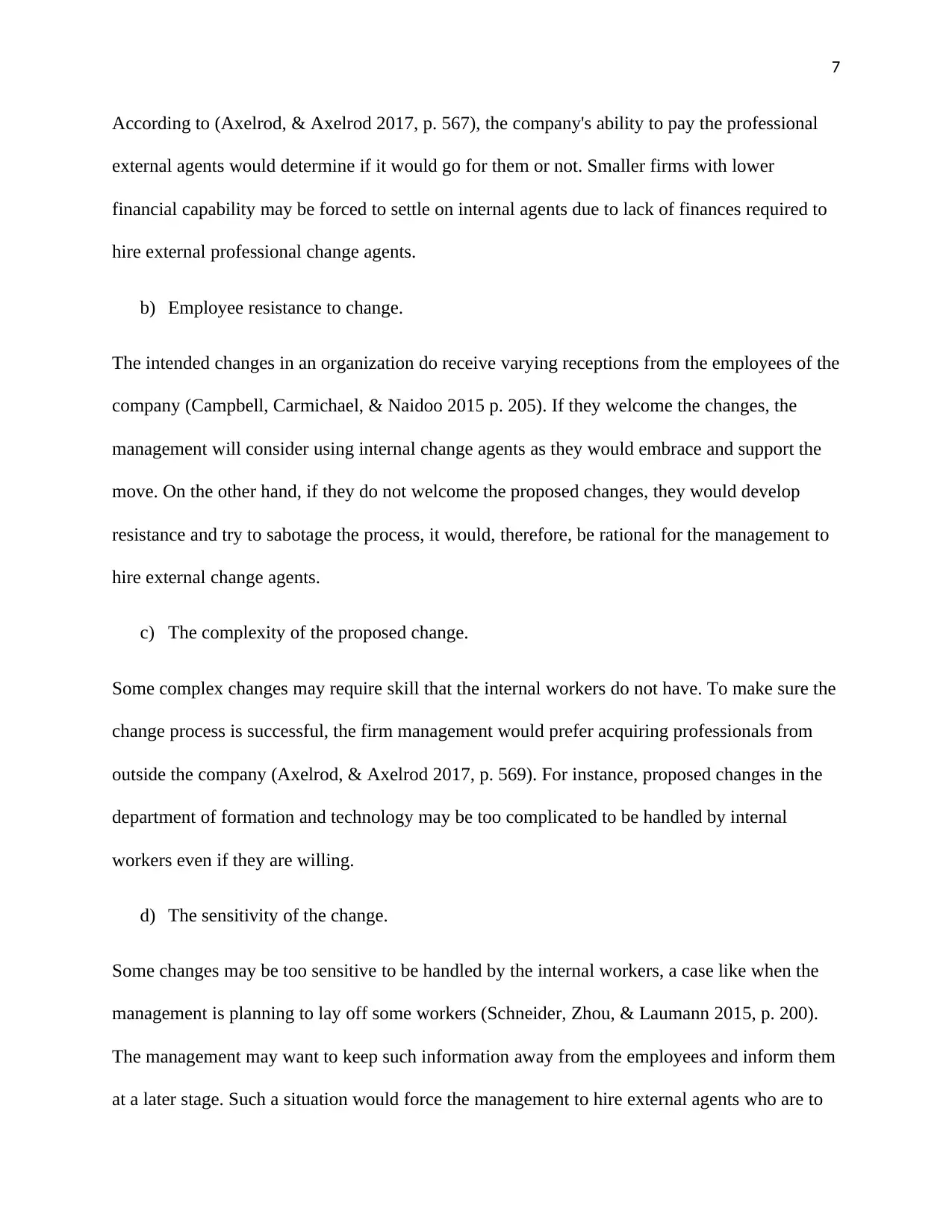
7
According to (Axelrod, & Axelrod 2017, p. 567), the company's ability to pay the professional
external agents would determine if it would go for them or not. Smaller firms with lower
financial capability may be forced to settle on internal agents due to lack of finances required to
hire external professional change agents.
b) Employee resistance to change.
The intended changes in an organization do receive varying receptions from the employees of the
company (Campbell, Carmichael, & Naidoo 2015 p. 205). If they welcome the changes, the
management will consider using internal change agents as they would embrace and support the
move. On the other hand, if they do not welcome the proposed changes, they would develop
resistance and try to sabotage the process, it would, therefore, be rational for the management to
hire external change agents.
c) The complexity of the proposed change.
Some complex changes may require skill that the internal workers do not have. To make sure the
change process is successful, the firm management would prefer acquiring professionals from
outside the company (Axelrod, & Axelrod 2017, p. 569). For instance, proposed changes in the
department of formation and technology may be too complicated to be handled by internal
workers even if they are willing.
d) The sensitivity of the change.
Some changes may be too sensitive to be handled by the internal workers, a case like when the
management is planning to lay off some workers (Schneider, Zhou, & Laumann 2015, p. 200).
The management may want to keep such information away from the employees and inform them
at a later stage. Such a situation would force the management to hire external agents who are to
According to (Axelrod, & Axelrod 2017, p. 567), the company's ability to pay the professional
external agents would determine if it would go for them or not. Smaller firms with lower
financial capability may be forced to settle on internal agents due to lack of finances required to
hire external professional change agents.
b) Employee resistance to change.
The intended changes in an organization do receive varying receptions from the employees of the
company (Campbell, Carmichael, & Naidoo 2015 p. 205). If they welcome the changes, the
management will consider using internal change agents as they would embrace and support the
move. On the other hand, if they do not welcome the proposed changes, they would develop
resistance and try to sabotage the process, it would, therefore, be rational for the management to
hire external change agents.
c) The complexity of the proposed change.
Some complex changes may require skill that the internal workers do not have. To make sure the
change process is successful, the firm management would prefer acquiring professionals from
outside the company (Axelrod, & Axelrod 2017, p. 569). For instance, proposed changes in the
department of formation and technology may be too complicated to be handled by internal
workers even if they are willing.
d) The sensitivity of the change.
Some changes may be too sensitive to be handled by the internal workers, a case like when the
management is planning to lay off some workers (Schneider, Zhou, & Laumann 2015, p. 200).
The management may want to keep such information away from the employees and inform them
at a later stage. Such a situation would force the management to hire external agents who are to
Paraphrase This Document
Need a fresh take? Get an instant paraphrase of this document with our AI Paraphraser
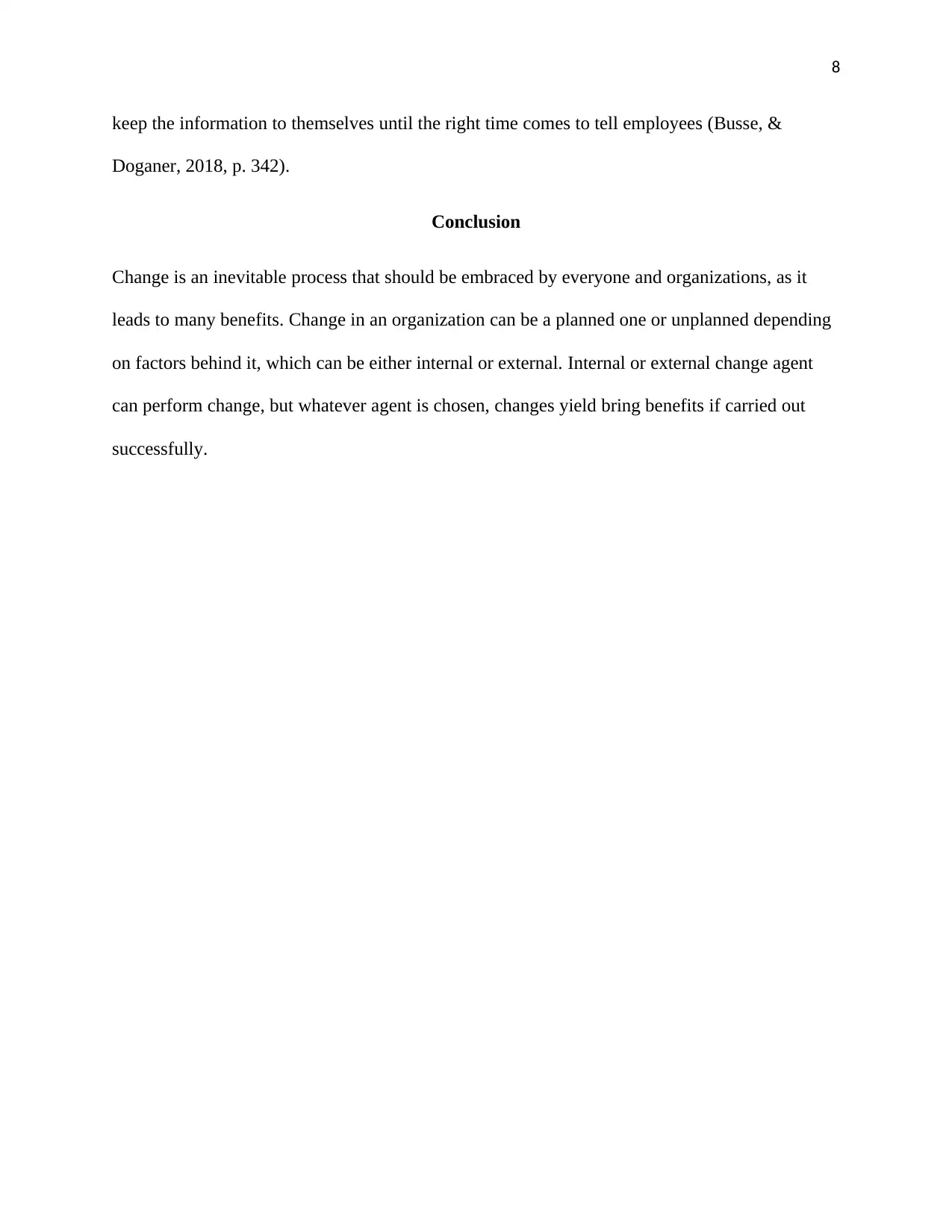
8
keep the information to themselves until the right time comes to tell employees (Busse, &
Doganer, 2018, p. 342).
Conclusion
Change is an inevitable process that should be embraced by everyone and organizations, as it
leads to many benefits. Change in an organization can be a planned one or unplanned depending
on factors behind it, which can be either internal or external. Internal or external change agent
can perform change, but whatever agent is chosen, changes yield bring benefits if carried out
successfully.
keep the information to themselves until the right time comes to tell employees (Busse, &
Doganer, 2018, p. 342).
Conclusion
Change is an inevitable process that should be embraced by everyone and organizations, as it
leads to many benefits. Change in an organization can be a planned one or unplanned depending
on factors behind it, which can be either internal or external. Internal or external change agent
can perform change, but whatever agent is chosen, changes yield bring benefits if carried out
successfully.
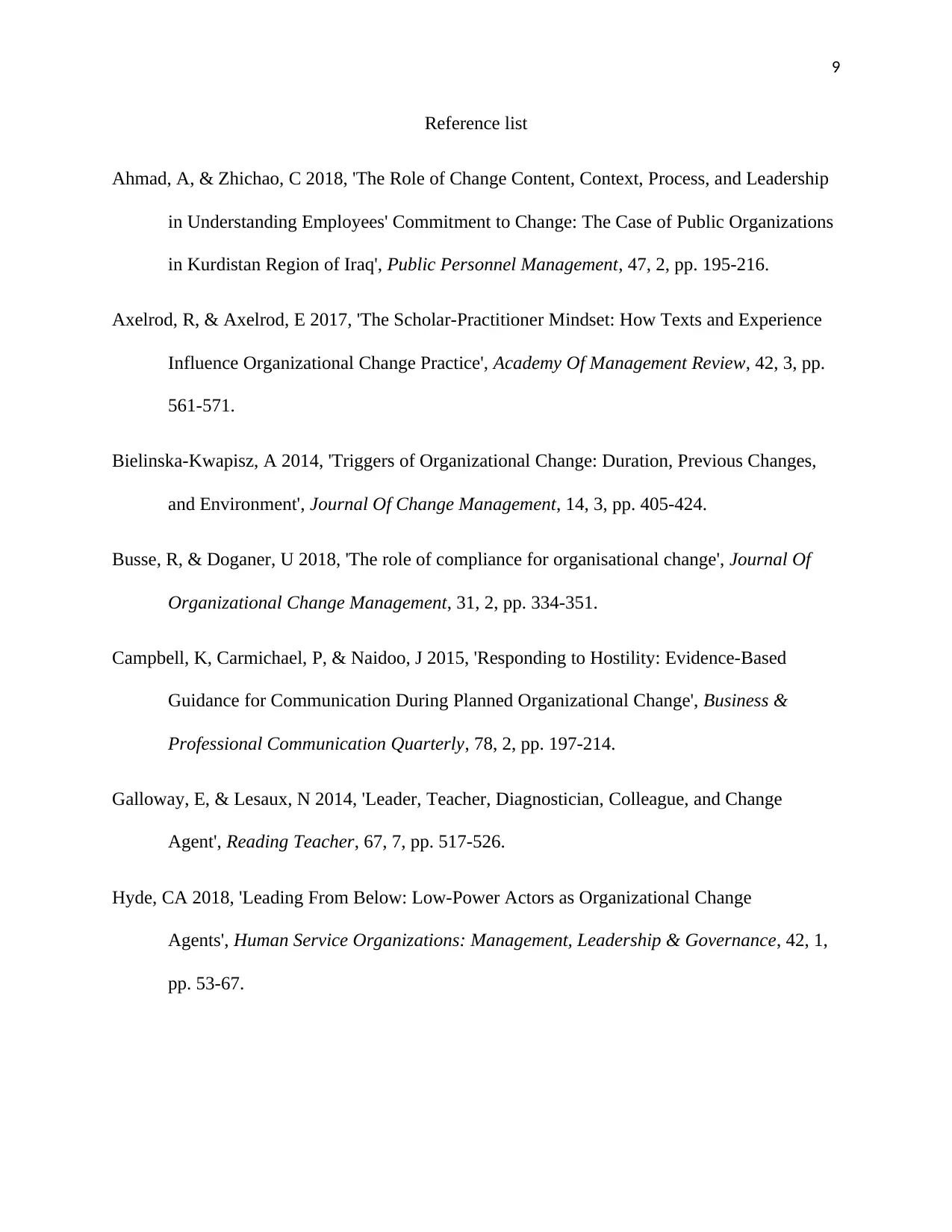
9
Reference list
Ahmad, A, & Zhichao, C 2018, 'The Role of Change Content, Context, Process, and Leadership
in Understanding Employees' Commitment to Change: The Case of Public Organizations
in Kurdistan Region of Iraq', Public Personnel Management, 47, 2, pp. 195-216.
Axelrod, R, & Axelrod, E 2017, 'The Scholar-Practitioner Mindset: How Texts and Experience
Influence Organizational Change Practice', Academy Of Management Review, 42, 3, pp.
561-571.
Bielinska-Kwapisz, A 2014, 'Triggers of Organizational Change: Duration, Previous Changes,
and Environment', Journal Of Change Management, 14, 3, pp. 405-424.
Busse, R, & Doganer, U 2018, 'The role of compliance for organisational change', Journal Of
Organizational Change Management, 31, 2, pp. 334-351.
Campbell, K, Carmichael, P, & Naidoo, J 2015, 'Responding to Hostility: Evidence-Based
Guidance for Communication During Planned Organizational Change', Business &
Professional Communication Quarterly, 78, 2, pp. 197-214.
Galloway, E, & Lesaux, N 2014, 'Leader, Teacher, Diagnostician, Colleague, and Change
Agent', Reading Teacher, 67, 7, pp. 517-526.
Hyde, CA 2018, 'Leading From Below: Low-Power Actors as Organizational Change
Agents', Human Service Organizations: Management, Leadership & Governance, 42, 1,
pp. 53-67.
Reference list
Ahmad, A, & Zhichao, C 2018, 'The Role of Change Content, Context, Process, and Leadership
in Understanding Employees' Commitment to Change: The Case of Public Organizations
in Kurdistan Region of Iraq', Public Personnel Management, 47, 2, pp. 195-216.
Axelrod, R, & Axelrod, E 2017, 'The Scholar-Practitioner Mindset: How Texts and Experience
Influence Organizational Change Practice', Academy Of Management Review, 42, 3, pp.
561-571.
Bielinska-Kwapisz, A 2014, 'Triggers of Organizational Change: Duration, Previous Changes,
and Environment', Journal Of Change Management, 14, 3, pp. 405-424.
Busse, R, & Doganer, U 2018, 'The role of compliance for organisational change', Journal Of
Organizational Change Management, 31, 2, pp. 334-351.
Campbell, K, Carmichael, P, & Naidoo, J 2015, 'Responding to Hostility: Evidence-Based
Guidance for Communication During Planned Organizational Change', Business &
Professional Communication Quarterly, 78, 2, pp. 197-214.
Galloway, E, & Lesaux, N 2014, 'Leader, Teacher, Diagnostician, Colleague, and Change
Agent', Reading Teacher, 67, 7, pp. 517-526.
Hyde, CA 2018, 'Leading From Below: Low-Power Actors as Organizational Change
Agents', Human Service Organizations: Management, Leadership & Governance, 42, 1,
pp. 53-67.
⊘ This is a preview!⊘
Do you want full access?
Subscribe today to unlock all pages.

Trusted by 1+ million students worldwide
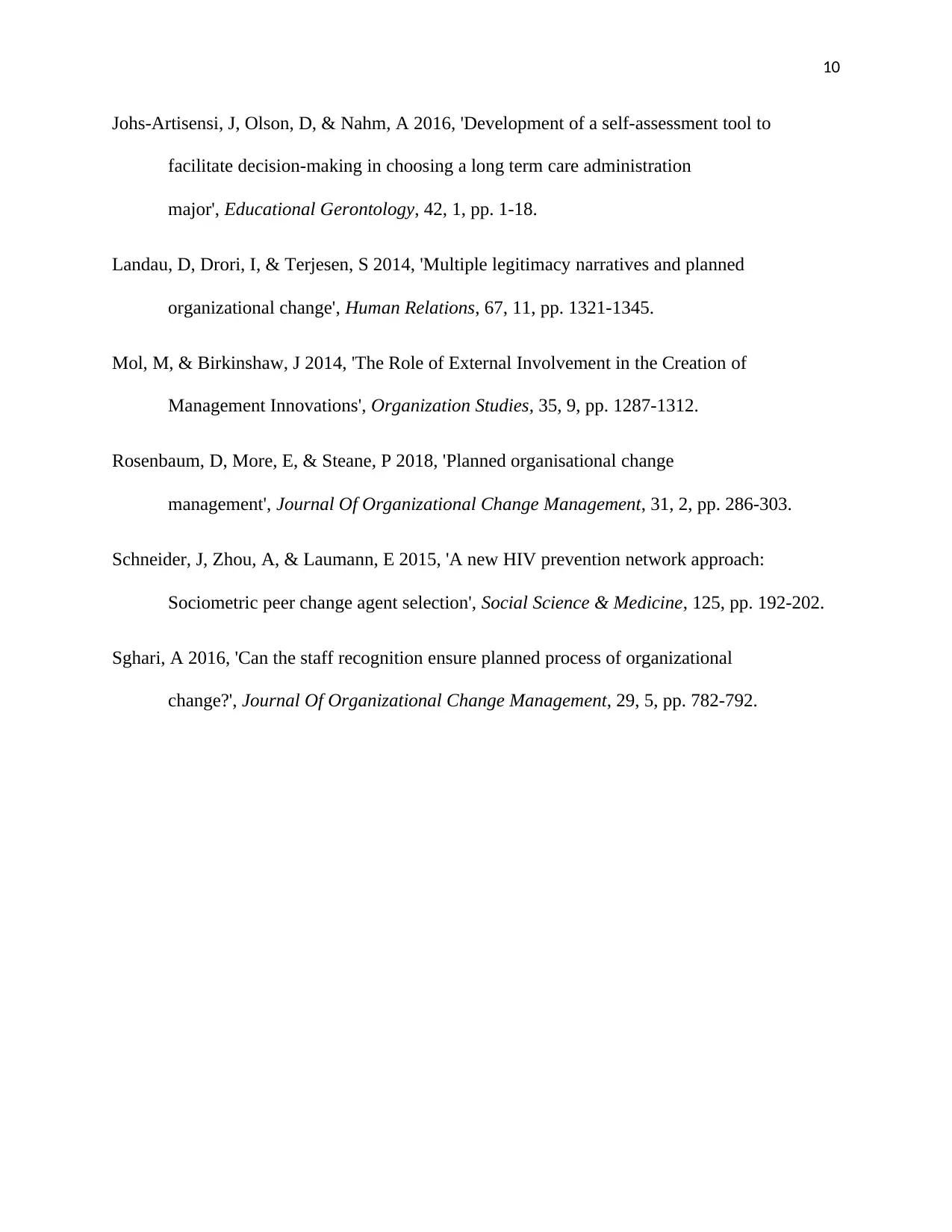
10
Johs-Artisensi, J, Olson, D, & Nahm, A 2016, 'Development of a self-assessment tool to
facilitate decision-making in choosing a long term care administration
major', Educational Gerontology, 42, 1, pp. 1-18.
Landau, D, Drori, I, & Terjesen, S 2014, 'Multiple legitimacy narratives and planned
organizational change', Human Relations, 67, 11, pp. 1321-1345.
Mol, M, & Birkinshaw, J 2014, 'The Role of External Involvement in the Creation of
Management Innovations', Organization Studies, 35, 9, pp. 1287-1312.
Rosenbaum, D, More, E, & Steane, P 2018, 'Planned organisational change
management', Journal Of Organizational Change Management, 31, 2, pp. 286-303.
Schneider, J, Zhou, A, & Laumann, E 2015, 'A new HIV prevention network approach:
Sociometric peer change agent selection', Social Science & Medicine, 125, pp. 192-202.
Sghari, A 2016, 'Can the staff recognition ensure planned process of organizational
change?', Journal Of Organizational Change Management, 29, 5, pp. 782-792.
Johs-Artisensi, J, Olson, D, & Nahm, A 2016, 'Development of a self-assessment tool to
facilitate decision-making in choosing a long term care administration
major', Educational Gerontology, 42, 1, pp. 1-18.
Landau, D, Drori, I, & Terjesen, S 2014, 'Multiple legitimacy narratives and planned
organizational change', Human Relations, 67, 11, pp. 1321-1345.
Mol, M, & Birkinshaw, J 2014, 'The Role of External Involvement in the Creation of
Management Innovations', Organization Studies, 35, 9, pp. 1287-1312.
Rosenbaum, D, More, E, & Steane, P 2018, 'Planned organisational change
management', Journal Of Organizational Change Management, 31, 2, pp. 286-303.
Schneider, J, Zhou, A, & Laumann, E 2015, 'A new HIV prevention network approach:
Sociometric peer change agent selection', Social Science & Medicine, 125, pp. 192-202.
Sghari, A 2016, 'Can the staff recognition ensure planned process of organizational
change?', Journal Of Organizational Change Management, 29, 5, pp. 782-792.
1 out of 10
Related Documents
Your All-in-One AI-Powered Toolkit for Academic Success.
+13062052269
info@desklib.com
Available 24*7 on WhatsApp / Email
![[object Object]](/_next/static/media/star-bottom.7253800d.svg)
Unlock your academic potential
Copyright © 2020–2025 A2Z Services. All Rights Reserved. Developed and managed by ZUCOL.





